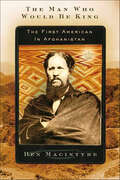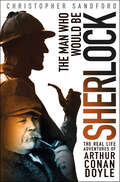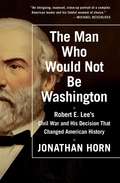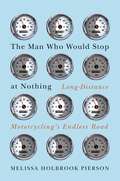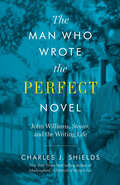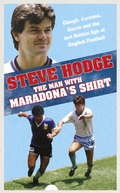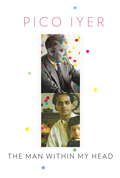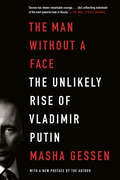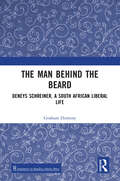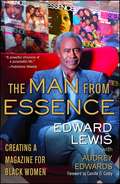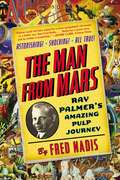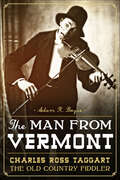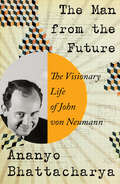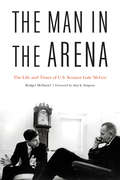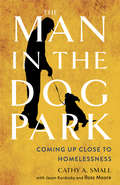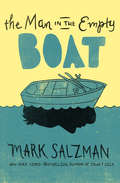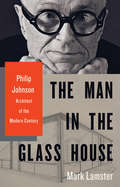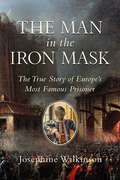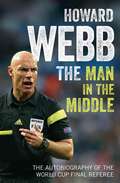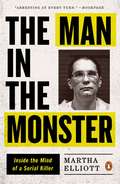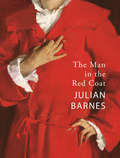- Table View
- List View
The Man Who Would Be King: The First American in Afghanistan
by Ben MacintyreThe untold story of the nineteenth-century American Quaker who tried to build a kingdom in Afghanistan: “A thrilling real-life yarn.” —BooklistIn the year 1838, a young adventurer, surrounded by his native troops and mounted on an elephant, raised the American flag on the summit of the Hindu Kush in the mountainous wilds of Afghanistan. He declared himself Prince of Ghor, Lord of the Hazarahs, spiritual and military heir to Alexander the Great.The true story of Josiah Harlan, a Pennsylvania Quaker and the first American ever to enter Afghanistan, has never been told before, yet the life and writings of this extraordinary man echo down the centuries. This “riveting, scrupulously researched” book reveals the full history behind the renowned Rudyard Kipling short story and John Huston’s film classic (The New York Times Book Review).“One of the most remarkable discoveries in the history of biography.” —The New York Review of Books“Macintyre recounts Harlan’s travels with dispatch, and draws on unpublished journals to let his subject’s voice seep through.” —The New Yorker“Here is a writer who seems as taken as I am with crackpottery, delusion, grandiosity, chicanery, and impersonation, but who manages to write about it all with amused restraint, without, that is, the air of the ogler.” —The Boston Globe“Macintyre gives readers both Harlan’s story and a thought-provoking perspective on the history of superpower intervention in Afghanistan . . . Harlan’s story alone is fascinating, but its resonance with modern-day struggles—Harlan urging the British to try ‘fiscal diplomacy’ (i.e., gold) instead of ‘invading and subjugating an unoffending people’—makes it compelling.” —Publishers Weekly
The Man Who Would Be President: Dan Quayle
by Bob Woodward David S. BroderAn assessment widely credited at the time.
The Man Who Would Be Sherlock: The Real Life Adventures of Arthur Conan Doyle
by Christopher SandfordA world-famous biographer reveals the strange relationship between Sir Arthur Conan Doyle's real life and that of Sherlock Holmes in the engrossing The Man Who Would Be Sherlock.Though best known for the fictional cases of his creation Sherlock Holmes, Conan Doyle was involved in dozens of real life cases, solving many, and zealously campaigning for justice in all. Stanford thoroughly and convincingly makes the case that the details of the many events Doyle was involved in, and caricatures of those involved, would provide Conan Doyle the fodder for many of the adventures of the violin-playing detective. There can be few (if any) literary creations who have found such a consistent yet evolving independent life as Holmes. He is a paradigm that can be endlessly changed yet always maintains an underlying consistent identity, both drug addict and perfect example of the analytic mind, and as Christopher Sandford demonstrates so clearly, in many of these respects he mirrors his creator.
The Man Who Would Not Be Washington: Robert E. Lee's Civil War and His Decision That Changed American History
by Jonathan HornThe “compelling…modern and readable perpective” (USA TODAY) of Robert E. Lee, the brilliant soldier bound by marriage to George Washington’s family but turned by war against Washington’s crowning achievement, the Union.On the eve of the Civil War, one soldier embodied the legacy of George Washington and the hopes of leaders across a divided land. Both North and South knew Robert E. Lee as the son of Washington’s most famous eulogist and the son-in-law of Washington’s adopted child. Each side sought his service for high command. Lee could choose only one. In The Man Who Would Not Be Washington, former White House speechwriter Jonathan Horn reveals how the officer most associated with Washington went to war against the union that Washington had forged. This extensively researched and gracefully written biography follows Lee through married life, military glory, and misfortune. The story that emerges is more complicated, more tragic, and more illuminating than the familiar tale. More complicated because the unresolved question of slavery—the driver of disunion—was among the personal legacies that Lee inherited from Washington. More tragic because the Civil War destroyed the people and places connecting Lee to Washington in agonizing and astonishing ways. More illuminating because the battle for Washington’s legacy shaped the nation that America is today. As Washington was the man who would not be king, Lee was the man who would not be Washington. The choice was Lee’s. The story is America’s. A must-read for those passionate about history, The Man Who Would Not Be Washington introduces Jonathan Horn as a masterly voice in the field.
The Man Who Would Stop at Nothing: Long-Distance Motorcycling's Endless Road
by Melissa Holbrook Pierson"Pierson is an even better writer than she is a rider."--Boston Globe "World's Toughest Motorcycle Riders"--long-distance motorcycling is not a pastime but an obsession. In this candid, eloquent, sharply observed book, Melissa Holbrook Pierson introduces us to this strange endeavor and the men and women who live to ride impossibly long distances, eating up road, almost without cease. And who find it nothing but fun. Perhaps the most determined of them is John Ryan, a magnetic, enigmatic man who loves nothing better than breaking records of amazing distance--at no small risk to himself and his health. But why? Pierson, who rediscovered the joys of motorcycling in the midst of a personal crisis, puts on her helmet and joins Ryan in his element in order to understand his singular desire and discipline, his passion and his obsession. The Man Who Would Stop at Nothing offers an intimate glimpse of an unusually independent yet supportive community as well as a revealing, unforgettable portrait of its most daring member. In electric, pitch-perfect prose, Pierson gives us rare insights into not only a subculture but also the deeply human craving for something more that drives it.
The Man Who Wrote the Perfect Novel: John Williams, Stoner, and the Writing Life
by Charles J. ShieldsAn &“engrossing&” biography of a brilliant novelist underappreciated in his own time who became a twenty-first-century bestseller, from the New York Times–bestselling author (The New Yorker). When Stoner was published in 1965, the novel sold only a couple of thousand copies before disappearing with hardly a trace. Yet the quietly powerful tale of Midwestern college professor William Stoner, whose life becomes a parable of solitude and anguish, eventually found an admiring audience in America and especially in Europe. The New York Times called Stoner &“a perfect novel,&” and a host of writers and critics, including Colum McCann, Julian Barnes, Bret Easton Ellis, Ian McEwan, Emma Straub, Ruth Rendell, C.P. Snow, and Irving Howe, praised its artistry. The New Yorker deemed it &“a masterly portrait of a truly virtuous and dedicated man.&” This biography traces the life of Stoner&’s author, John Williams. Charles J. Shields follows the whole arc of Williams&’s life, which in many ways paralleled that of his titular character, from their shared working-class backgrounds to their undistinguished careers in academia. Shields vividly recounts Williams&’s development as an author, whose other works include the novels Butcher&’s Crossing and Augustus (for the latter, Williams shared the 1972 National Book Award). Shields also reveals the astonishing afterlife of Stoner, which garnered new fans with each American reissue, and then became a bestseller all over Europe after a Dutch publisher brought out a translation in 2013. Since then, Stoner has been published in twenty-one countries and sold over a million copies. &“Like Williams, Shields know how to tell a good story, one that will appeal especially to those interested in the ins and outs of the publishing industry and the ups and downs of a writer&’s life.&” —Los Angeles Review of Books
The Man Who Wrote the Perfect Novel: John Williams, Stoner, and the Writing Life
by Charles J. ShieldsAn &“engrossing&” biography of a brilliant novelist underappreciated in his own time who became a twenty-first-century bestseller, from the New York Times–bestselling author (The New Yorker). When Stoner was published in 1965, the novel sold only a couple of thousand copies before disappearing with hardly a trace. Yet the quietly powerful tale of Midwestern college professor William Stoner, whose life becomes a parable of solitude and anguish, eventually found an admiring audience in America and especially in Europe. The New York Times called Stoner &“a perfect novel,&” and a host of writers and critics, including Colum McCann, Julian Barnes, Bret Easton Ellis, Ian McEwan, Emma Straub, Ruth Rendell, C.P. Snow, and Irving Howe, praised its artistry. The New Yorker deemed it &“a masterly portrait of a truly virtuous and dedicated man.&” This biography traces the life of Stoner&’s author, John Williams. Charles J. Shields follows the whole arc of Williams&’s life, which in many ways paralleled that of his titular character, from their shared working-class backgrounds to their undistinguished careers in academia. Shields vividly recounts Williams&’s development as an author, whose other works include the novels Butcher&’s Crossing and Augustus (for the latter, Williams shared the 1972 National Book Award). Shields also reveals the astonishing afterlife of Stoner, which garnered new fans with each American reissue, and then became a bestseller all over Europe after a Dutch publisher brought out a translation in 2013. Since then, Stoner has been published in twenty-one countries and sold over a million copies. &“Like Williams, Shields know how to tell a good story, one that will appeal especially to those interested in the ins and outs of the publishing industry and the ups and downs of a writer&’s life.&” —Los Angeles Review of Books
The Man With Maradona's Shirt
by Steve HodgeIntimate, behind-the-scenes account of the last age of innocence in football, just prior to the Premiership, based on the England midfielder's diaries.This is not a straightforward autobiography, it's a snapshot of a vanished era of football. The 1980s and the early 1990s was the last era of (relative) innocence in football. Steve Hodge played alongside Hoddle, Waddle and Ardiles in the lauded mid-1980s Spurs midfield; he was a dressing-room witness to the vagaries, charm, whims and downright venomous side of Brian Clough; he was at two World Cups, being instrumental in the 'hand of God' episode, and hanging out with the likes of Gazza and Lineker four years later in Italy. He won the last League Championship medal with Leeds, then languished in the reserves with a 'somewhat shy', cultured Frenchman. As the balls would fly over the midfield - Howard Wilkinson being a disciple of route one - Eric Cantona would turn to him and repeatedly ask, 'Hodgey, why are we here?' THE MAN WITH MARADONA'S SHIRT is a fascinating, behind-the-scenes glimpse of life at the top.
The Man With Maradona's Shirt
by Steve HodgeIntimate, behind-the-scenes account of the last age of innocence in football, just prior to the Premiership, based on the England midfielder's diaries.This is not a straightforward autobiography, it's a snapshot of a vanished era of football. The 1980s and the early 1990s was the last era of (relative) innocence in football. Steve Hodge played alongside Hoddle, Waddle and Ardiles in the lauded mid-1980s Spurs midfield; he was a dressing-room witness to the vagaries, charm, whims and downright venomous side of Brian Clough; he was at two World Cups, being instrumental in the 'hand of God' episode, and hanging out with the likes of Gazza and Lineker four years later in Italy. He won the last League Championship medal with Leeds, then languished in the reserves with a 'somewhat shy', cultured Frenchman. As the balls would fly over the midfield - Howard Wilkinson being a disciple of route one - Eric Cantona would turn to him and repeatedly ask, 'Hodgey, why are we here?' THE MAN WITH MARADONA'S SHIRT is a fascinating, behind-the-scenes glimpse of life at the top.
The Man Within My Head
by Pico IyerWe all carry people inside our heads--actors, leaders, writers, people out of history or fiction, met or unmet, who sometimes seem closer to us than people we know. In The Man Within My Head, Pico Iyer sets out to unravel the mysterious closeness he has always felt with the English writer Graham Greene; he examines Greene's obsessions, his elusiveness, his penchant for mystery. Iyer follows Greene's trail from his first novel, The Man Within, to such later classics as The Quiet American and begins to unpack all he has in common with Greene: an English public school education, a lifelong restlessness and refusal to make a home anywhere, a fascination with the complications of faith. The deeper Iyer plunges into their haunted kinship, the more he begins to wonder whether the man within his head is not Greene but his own father, or perhaps some more shadowy aspect of himself. Drawing upon experiences across the globe, from Cuba to Bhutan, and moving, as Greene would, from Sri Lanka in war to intimate moments of introspection; trying to make sense of his own past, commuting between the cloisters of a fifteenth-century boarding school and California in the 1960s, one of our most resourceful explorers of crossing cultures gives us his most personal and revelatory book.
The Man Without a Face: The Unlikely Rise of Vladimir Putin
by Masha GessenThe Man Without a Face is the chilling account of how a low- level, small-minded KGB operative ascended to the Russian presidency and, in an astonishingly short time, destroyed years of progress and made his country once more a threat to her own people and to the world. Handpicked as a successor by the "family" surrounding an ailing and increasingly unpopular Boris Yeltsin, Vladimir Putin seemed like a perfect choice for the oligarchy to shape according to its own designs. Suddenly the boy who had stood in the shadows, dreaming of ruling the world, was a public figure, and his popularity soared. Russia and an infatuated West were determined to see the progressive leader of their dreams, even as he seized control of media, sent political rivals and critics into exile or to the grave, and smashed the country's fragile electoral system, concentrating power in the hands of his cronies. As a journalist living in Moscow, Masha Gessen experienced this history firsthand, and for The Man Without a Face she has drawn on information and sources no other writer has tapped. Her account of how a "faceless" man maneuvered his way into absolute-and absolutely corrupt-power has the makings of a classic of narrative nonfiction. .
The Man and His Bike: Musings on life and the art of cycling
by Wilfried de JongThe world as seen from a bike'Understated, comic and melancholic... It’ll inspire you to get back on your bike.' Martin Love, The Guardian‘One of the most entertaining sports books I have ever read’ Joe Short, The Daily ExpressIn this award-winning collection of cycling tales, Wilfried de Jong uncovers the true soul of cycling – why we do it, why we watch it, why we hate it, why we love it – stripped bare.With his distinctly comic and melancholic charm Wilfried ponders life, love and death on his trusted bike, chasing the essence of our existence against the backdrop of major cycling events or while roaming alone in nature. Whether he is describing being ejected from Paris-Roubaix, a terminal incident with a bird while out riding, or explaining why he is standing stark naked on Belgian cobbles with a tyre in his hand, Wilfried unlocks a sport that involves so much pain, punishment, and a high probability of failure, but that will always liberate and inspire us.
The Man behind the Beard: Deneys Schreiner, a South African Liberal Life
by Graham DominyDeneys Schreiner was an academic, a scientist and a man of strong liberal principles, with a good sense of humor and widespread interests in the sciences, arts and public affairs. In his steady way, he transformed the University of Natal and the community around it. Between the 1960s and 1980s, Schreiner supported and initiated several endeavors to promote constitutional futures other than those imposed by the apartheid government. One of the most significant was the Buthelezi Commission, which he chaired. This biography sets out the context of the times in which Schreiner lived and his life from his ancestors to his tenure as Vice-Principal. This book is created with extensive archival research, supported by interviews with family members, former colleagues, friends, and journalists. Schreiner was a man who made a considerable contribution to the struggle for democracy in South Africa. And then there is the story of his beard, once described as a potent symbol of his presence and implacable integrity. Print edition not for sale in Sub Saharan Africa.
The Man from Essence: Creating a Magazine for Black Women
by Edward LewisEssence magazine is the most popular, well respected, and largest circulated black women&’s magazine in history. Largely unknown is the remarkable story of what it took to earn that distinction.The Man from Essence depicts with candor and insight how Edward Lewis, CEO and publisher of Essence, started a magazine with three black men who would transform the lives of millions of black American women and alter the American marketplace. Throughout Essence&’s storied history, Ed Lewis remained the cool and constant presence, a quiet-talking corporate captain and business strategist who prevailed against the odds and the naysayers. He would emerge to become the last man standing—the only partner to survive the battles that raged before the magazine was sold to Time, Inc. in the largest buyout of a black-owned publication by the world&’s largest publishing company. By the time Lewis did the deal with Time, the little magazine that limped from the starting gate in 1970 with a national circulation of 50,000, had grown into a powerhouse with a readership of eight million. The story of Essence is ultimately the story of American business, black style. From constant battles with a racist advertising community to hostile takeover attempts, warring partners packing heat, mass firings, and mass defections—all of which revealed inherent challenges in running a black business—the saga is as riveting as any thriller. In this engaging business memoir, Ed Lewis tells the inspiring story of how his own rise from humble South Bronx beginnings to media titan was shaped by the black women and men in his life. This in turn helped shape a magazine that has changed the face of American media.
The Man from Mars
by Fred NadisThe rollicking true story of the legendary writer and editor who ruled over America's fantasy and supernatural pulp journals in the mid-twentieth century, and shaped today's UFO and sci-fi cultures: Ray Palmer. Meet Ray Palmer. A hustler, a trickster, and a visionary. The hunchbacked Palmer, who stood at just over four feet tall, was nevertheless an indomitable force, the ruler of his own bizarre sector of the universe. Armed with only his typewriter, Palmer changed the world as we know it - jumpstarting the flying saucer craze; frightening hundreds of thousands of Americans with "true" stories of evil denizens of inner earth; and reporting on cover-ups involving extraterrestrials, the paranormal, and secret government agencies. As editor for the ground-breaking sci-fi magazine Amazing Stories and creator of publications such as Other Worlds, Imagination, Fate, Mystic, Search, Flying Saucers, Hidden World, and Space Age, Palmer pushed the limits and broke new ground in science fiction publishing in the 1940s and 1950s--and was reviled for it by purists who called him "the man who killed science fiction." In the first-ever biography devoted to the figure who molded modern geek culture, pulp scholar Fred Nadis paints a vivid portrait of Palmer--a brilliant, charming, and wildly willful iconoclast who helped ignite the UFO craze, convinced Americans of hidden worlds and government cover ups, and championed the occult and paranormal. Palmer overcame serious physical handicaps to become the most significant editor during the "golden age" of pulp magazines; he rebelled in his own inimitable way against the bland suburban vision of the American Dream; he concocted new literary genres; and he molded our current conspiracy culture decades before The X-Files claimed that the truth was out there.
The Man from Vermont: Charles Ross Taggart Old Country Fiddler
by Adam R. BoyceIn 1895, East Topsham's Charles Ross Taggart set his sights on becoming a traveling musical humorist. His uproarious ventriloquist and musical performances brought rave reviews in his Vermont community. He was soon thrust into the world of the lyceum and Chautauqua circuits, journeying far and wide across North America. His forty-three-year career spanned some of America's most exciting and most difficult times, and his folk performances--especially his beloved "Old Country Fiddler"--brought smiles to all who experienced them. He was also an innovator in the entertainment industry, recording his music and humor, as well as appearing in one of the first "talkie" films. Discover the remarkable story of "The Man from Vermont" who helped Americans forget their troubles when they needed it most with his mimicry, stories and fiddling.
The Man from the Future: The Visionary Life of John von Neumann
by Ananyo BhattacharyaAn electrifying biography of one of the most extraordinary scientists of the twentieth century and the world he made. The smartphones in our pockets and computers like brains. The vagaries of game theory and evolutionary biology. Nuclear weapons and self-replicating spacecrafts. All bear the fingerprints of one remarkable, yet largely overlooked, man: John von Neumann. Born in Budapest at the turn of the century, von Neumann is one of the most influential scientists to have ever lived. A child prodigy, he mastered calculus by the age of eight, and in high school made lasting contributions to mathematics. In Germany, where he helped lay the foundations of quantum mechanics, and later at Princeton, von Neumann’s colleagues believed he had the fastest brain on the planet—bar none. He was instrumental in the Manhattan Project and the design of the atom bomb; he helped formulate the bedrock of Cold War geopolitics and modern economic theory; he created the first ever programmable digital computer; he prophesized the potential of nanotechnology; and, from his deathbed, he expounded on the limits of brains and computers—and how they might be overcome. Taking us on an astonishing journey, Ananyo Bhattacharya explores how a combination of genius and unique historical circumstance allowed a single man to sweep through a stunningly diverse array of fields, sparking revolutions wherever he went. The Man from the Future is an insightful and thrilling intellectual biography of the visionary thinker who shaped our century.
The Man in the Arena: The Life and Times of U.S. Senator Gale McGee
by Alan K. Simpson Rodger McDanielThere was a time when Wyoming and other Rocky Mountain and midwestern states were as likely to elect a liberal Democrat to Congress as they were a conservative Republican. Gale McGee (1915–92) was elected to the U.S. Senate in 1958, at the height of American liberalism. He typified what Teddy Roosevelt called “the man in the arena” and was a major player in the development of America’s post–World War II foreign policy and almost every legislative milestone in U.S. history from the 1950s to 1980. McGee’s careers as an academic, a senator, and an ambassador spanned World War II, the Red Scare, the Korean and Vietnam Wars, and the activist Congress of the 1960s. This elegantly conceived biography of a liberal from the conservative rural state of Wyoming offers readers a glimpse into formative political shifts of the twentieth century. The national liberal consensus of the 1960s, in which McGee played a major role, gave the nation Social Security, Medicare, Medicaid, the minimum wage, and the right to collective bargaining, as well as landmark civil rights and environmental reforms. That consensus had ended by the mid-1970s as McGee’s liberalism would no longer be welcome to represent the Equality State. Moving beyond biography, Rodger McDaniel addresses the significant shift in government and details how the attribution “liberal” became a candidate’s epitaph, as widespread distrust of government cast a shadow on the many benefits acquired through the old liberal consensus. McDaniel’s insights into the past as well as McGee’s experiences in the arena shed unexpected light on the present state of U.S. politics and government.
The Man in the Dog Park: Coming Up Close to Homelessness
by Cathy A. SmallThe Man in the Dog Park offers the reader a rare window into homeless life.Spurred by a personal relationship with a homeless man who became her co-author, Cathy A. Small takes a compelling look at what it means and what it takes to be homeless. Interviews and encounters with dozens of homeless people lead us into a world that most have never seen. We travel as an intimate observer into the places that many homeless frequent, including a community shelter, a day labor agency, a panhandling corner, a pawn shop, and a HUD housing office.Through these personal stories, we witness the obstacles that homeless people face, and the ingenuity it takes to negotiate life without a home. The Man in the Dog Park points to the ways that our own cultural assumptions and blind spots are complicit in US homelessness and contribute to the degree of suffering that homeless people face. At the same time, Small, Kordosky and Moore show us how our own sense of connection and compassion can bring us into touch with the actions that will lessen homelessness and bring greater humanity to the experience of those who remain homeless.The raw emotion of The Man in the Dog Park will forever change your appreciation for, and understanding of, the homeless life so many deal with outside of the limelight of contemporary society.
The Man in the Empty Boat
by Mark SalzmanFrom the author of Iron & Silk comes a moving memoir of love and family, loss and spiritual yearningAnxiety has always been part of Mark Salzman&’s life: He was born into a family as nervous as rabbits, people with extra angst coded into their genes. As a young man he found solace through martial arts, meditation, tai chi, and rigorous writing schedules, but as he approaches midlife, he confronts a year of catastrophe. First, Salzman suffers a crippling case of writer&’s block; then a sudden family tragedy throws his life into chaos. Overwhelmed by terrifying panic attacks, the author begins a search for equanimity that ultimately leads to an epiphany from a most unexpected source. The Man in the Empty Boat is a witty and touching account of a skeptic&’s spiritual quest, a story of one man&’s journey to find peace as a father, a writer, and an individual.
The Man in the Glass House: Philip Johnson, Architect of the Modern Century
by Mark LamsterWhen Philip Johnson died in 2005 at the age of 98, he was still one of the most recognizable--and influential--figures on the American cultural landscape. The first recipient of the Pritzker Prize and MoMA's founding architectural curator, Johnson made his mark as one of America's leading architects with his famous Glass House in New Caanan, CT, and his controversial AT&T Building in NYC, among many others in nearly every city in the country--but his most natural role was as a consummate power broker and shaper of public opinion.Johnson introduced European modernism--the sleek, glass-and-steel architecture that now dominates our cities--to America, and mentored generations of architects, designers, and artists to follow. He defined the era of "starchitecture" with its flamboyant buildings and celebrity designers who esteemed aesthetics and style above all other concerns. But Johnson was also a man of deep paradoxes: he was a Nazi sympathizer, a designer of synagogues, an enfant terrible into his old age, a populist, and a snob. His clients ranged from the Rockefellers to televangelists to Donald Trump.Award-winning architectural critic and biographer Mark Lamster's THE MAN IN THE GLASS HOUSE lifts the veil on Johnson's controversial and endlessly contradictory life to tell the story of a charming yet deeply flawed man. A rollercoaster tale of the perils of wealth, privilege, and ambition, this book probes the dynamics of American culture that made him so powerful, and tells the story of the built environment in modern America.
The Man in the Iron Mask: The True Story of Europe's Most Famous Prisoner
by Wilkinson JosephineA vivid, dramatic, and eye-opening historical narrative, The Man in the Iron Mask reveals the story behind the most enduring mystery of Louis XIV&’s reign.The Man in the Iron Mask has all the hallmarks of a thrilling adventure story: a glamorous and all-powerful king, ambitious ministers, a cruel and despotic jailor, dark and sinister dungeons— and a secret prisoner. It is easy for forget that this story, made famous by Alexandre Dumas, is that of a real person, Eustache Danger, who spent more than thirty years in the prison system of Louis XIV&’s France—never to be freed. This narrative brings to life the true story of this mysterious man and follows his journey through four prisons and across decades of time. It introduces the reader to those with whom he shared his imprisonment, those who had charge of him, and those who decided his tragic fate. The Man in the Iron Mask reveals one of the most enduring mysteries of Louis XIV&’s reign; but it is, above all, a human story. Using contemporary documents, this book shows what life was really like for state prisoners in seventeenth-century France—and offers tantalising insight into why this mysterious man was arrested and why, several years later, his story would become one of France&’s most intriguing legends that still sparks debate and controversy today.
The Man in the Middle: The Autobiography of the World Cup Final Referee
by Howard Webb<p>The long-awaited autobiography of Howard Webb, the man who refereed the World Cup final. <p>Webb's first game as a match official came when he was just 18 and his father's verdict was blunt: 'Useless - he doesn't know his arse from his elbow.' It wasn't the last time his performance would come under fire. But Webb progressed through the ranks, and his natural calm authority made a good impression on players and administrators alike, and soon he was being offered the top matches and the toughest fixtures. <p>The policeman went on to take charge of some of the most important games, including the 2009 FA Cup final, the 2010 Champions League final and - the biggest of the lot - the 2010 World Cup final. Now, in this superb and honest memoir, Howard Webb reveals what it is like to be at the heart of the action in the modern-day game where every decision can be unpicked by television cameras. He explains how he learned to handle some of the game's superstars. Refereeing is a hard business, but Webb shows just why he enjoyed it so much and provides fascinating insights into how he dealt with the most challenging situations. <p>With his unique perspective on the game, and the characteristic honesty he has displayed as a pundit on BT Sport, Webb has written a book that reveals the game - and the man himself - in a new light.
The Man in the Monster: An Intimate Portrait of a Serial Killer
by Martha ElliottAn astonishing portrait of a murderer and his complex relationship with a crusading journalist. Michael Ross was a serial killer who raped and murdered eight young women between 1981 and 1984, and several years ago the state of Connecticut put him to death. His crimes were horrific, and he paid the ultimate price for them. When journalist Martha Elliott first heard of Ross, she learned what the world knew of him-- that he had been a master at hiding in plain sight. Elliott, a staunch critic of the death penalty, was drawn to the case when the Connecticut Supreme Court overturned Ross's six death sentences. Rather than fight for his life, Ross requested that he be executed because he didn't want the families of his victims to suffer through a new trial. Elliott was intrigued and sought an interview. The two began a weekly conversation--that developed into an odd form of friendship--that lasted over a decade, until Ross's last moments on earth.Over the course of his twenty years in prison, Ross had come to embrace faith for the first time in his life. He had also undergone extensive medical treatment. The Michael Ross whom Elliott knew seemed to be a different man from the monster who was capable of such heinous crimes. This Michael Ross made it his mission to share his story with Elliott in the hopes that it would save lives. He was her partner in unlocking the mystery of his own evil.In The Man in the Monster, Martha Elliott gives us a groundbreaking look into the life and motivation of a serial killer. Drawing on a decade of conversations and letters between Ross and the author, readers are given an in-depth view of a killer's innermost thoughts and secrets, revealing the human face of a monster--without ignoring the horrors of his crimes. Elliott takes us deep into a world of court hearings, tomblike prisons, lawyers hell-bent to kill or to save--and families ravaged by love and hate. This is the personal story of a journalist who came to know herself in ways she could never have imagined when she opened the notebook for that first interview.
The Man in the Red Coat
by Julian BarnesThe Man Booker Prize-winning author of The Sense of an Ending takes us on a rich, witty, revelatory tour of Belle Époque Paris, via the life story of the pioneering surgeon Samuel Pozzi. IN THE SUMMER OF 1885, three Frenchmen arrived in London for a few days' shopping: a prince, a count and a commoner with an Italian name. In time, each of these men would achieve a certain level of renown, but who were they then and what was the significance of their sojourn to England? Answering these questions, Julian Barnes unfurls the stories of their lives, playing out against the backdrop of the Belle Époque in Paris. Our guide through this world is Samuel Pozzi, the society doctor, free-thinker and man of science with a famously complicated private life, and the subject of one of John Singer Sargent's greatest portraits.In this vivid tapestry of people (Henry James, Sarah Bernhardt, Oscar Wilde, Proust, James Whistler, among many others), place, and time, we see not merely an epoch of glamour and pleasure, but, surprisingly, one of violence, prejudice and nativism--with more parallels to our own age than we might imagine. The Man in the Red Coat is, at once, a fresh portrait of the Belle Époque; an illuminating look at the longstanding exchange of ideas between Britain and France; and a life of a man who lived passionately in the moment but whose ideas and achievements were far ahead of his time.
